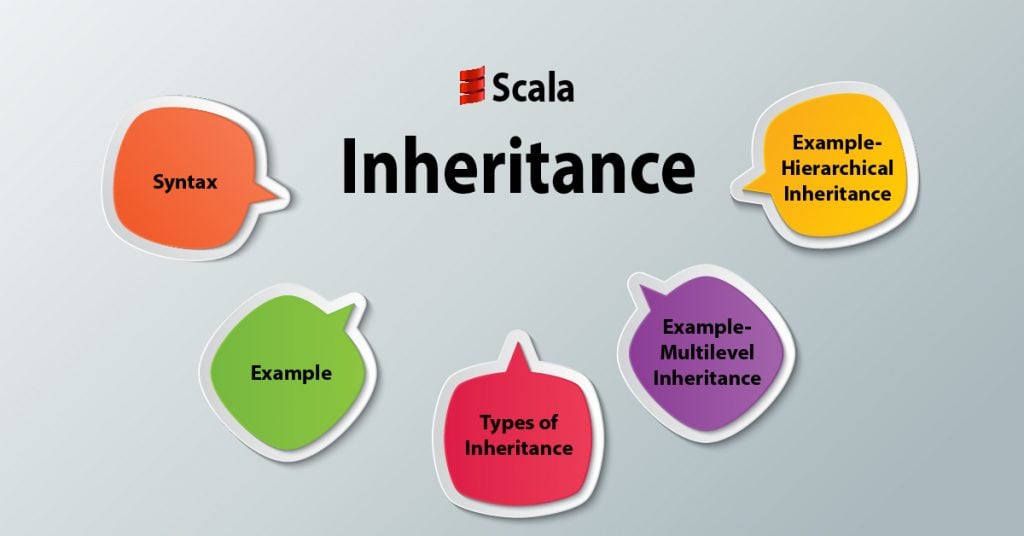Free Scala course with real-time projects Start Now!!
In our last Scala Tutorial, we discuss Scala Case Class. Now, we will discuss Scala inheritance with syntax and examples. Along with this, we will cover different types of inheritance in Scala Programming. At last, we will see examples of multilevel inheritance and Hierarchical Inheritance in Scala.
Scala Inheritance – Syntax, Example & Types of Inheritance in Scala
Scala Inheritance
When a class inherits from another, it means it extends another. We use the ‘extends’ keyword for this. This lets a class inherit members from the one it extends and lets us reuse code.
Let’s Learn Scala Map with Examples Quickly & Effectively
The class that extends is the subclass, the child class, or the derived class. The other class is the superclass, the parent class, or the base class.
It is an IS-A relationship. You can also call it a generalization. A Student is a Person.
A syntax of Scala Inheritance
To carry out Scala inheritance, we use the keyword ‘extends’:
class Student extends Person(){
/*your code
*goes here
*/
Let’s Discuss Scala String Interpolation – s String, f String and raw string Interpolator
Scala Inheritance Example
Let’s take an example of Inheritance.
scala> class Person{
| var SSN:String="999-32-7869"
| }
defined class Person
scala> class Student extends Person{
| var enrolment_no:String="0812CS141028"
| println("SSN: "+SSN)
| println("Enrolment Number: "+enrolment_no)
| }
defined class Student
scala> new Student()
SSN: 999-32-7869
Enrolment Number: 0812CS141028
res0: Student = Student@42cfd794
In this example, we have two classes- Person and Student. We make Student extend Person. This means a Student is a Person.
Since Student extends Person, it inherits the attribute holding the social security number. In class Student, we print SSN and enrolment_no. Finally, we create an object of class Student.
Types of Inheritance in Scala
Scala supports five kinds of inheritance:
a. Single-level Inheritance in Scala
Scala Single-level inheritance is when one class inherits from a single other class.
Read about Scala Access Modifiers: Public, Private and Protected Members
b. Multilevel Inheritance in Scala
When one class extends another, which in turn extends another, it is an instance of multilevel inheritance.
Let’s Scala if-else Statements with examples
c. Multiple Inheritance in Scala
When one class inherits from multiple base classes, it is a case of multiple inheritances.
d. Hierarchical Inheritance in Scala
When more than one class inherits from one base class, it is said to be hierarchical inheritance.
e. Hybrid Inheritance in Scala
Scala Hybrid inheritance is a combination of at least two kinds of inheritance.
Let’s explore Scala Operator in detail
Multilevel Inheritance Example – 1
scala> class A{
| println("A")
| }
defined class A
scala> class B extends A{
| println("B")
| }
defined class B
scala> class C extends B{
| println("C")
| }
defined class C
scala> new C()
A
B
C
res1: C = C@347f8029
In this example, we observe that class C extends class B and class B extends A.
Example – 2
Take a look at this code:
object Multiple{
def main(args: Array[String]):Unit={
trait A{
var length:Int= _
def action={
length=length+5
}
}
trait B{
var height:Int = _
def action={
height = height + 1
}
}
class C extends A with B{
length=3;
height+=6;
override def action={
super[A].action
super[B].action
}
}
var c=new C
c.action
println(c.height)
println(c.length)
}
}
Here, we make use of traits to let class C inherit from traits A and B.
Example- Hierarchical Inheritance
scala> class A{
| println("A")
| }
defined class A
scala> class B extends A{
| println("B")
| }
defined class B
scala> class C extends A{
| println("C")
| }
defined class C
scala> new B()
A
B
res2: B = B@64c1a76e
scala> new C()
A
C
res3: C = C@193f5509
In this example, classes B and C inherit from class A.
Do you know Scala Job Opportunities: Profile, Salary & Top Organizations
Conclusion
Hence, we studied what is Inheritance in Scala with example and syntax. In addition, we saw different types of inheritance. If you have a doubt, feel free to ask in the comment section.
Related Topic- Scala Closures with Examples
For reference
